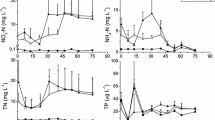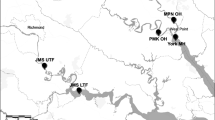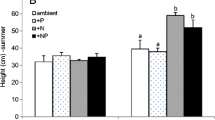Abstract
Three fresh- to brackish-water coastal lakes and streams at the upland-estuary interface of Barataria Basin, Louisiana, were studied for a one-year period. Measurements of community production and metabolism, chlorophyll a, and water column nitrogen and phosphorus were used to assess the functional relationship the upland connection has with the estuary. Aquatic community gross production was highest in the lake immediately adjacent to the New Orleans West Bank uplands (696 g C m-2 yr-1). A pattern of decreasing community hetero- trophy was exhibited in the lakes from upland to the lower estuary. Active chlorophyll a, nitrogen, and phosphorus were also highest in the streams and lake adjacent to the upland area. Chlorophyll a averaged over 55 mg m-3 at these locations; remaining stations averaged only 11 mg m-3. Nutrient levels were lowest in lakes, suggesting incorporation into plant biomass and sediments. Dissolved carbon and nutrient components made up an average of 78% of total concentrations.
Spatial distribution of selected water chemistry parameters indicates that artificial drainage and navigation canals in the estuarine and upland area have changed the hydrologic regime. Nutrient loading rates and high production values indicate that the area immediately adjacent to the upland is currently hypereutrophic. Its potential to absorb increasing nutrient loads is in doubt. Altered hydrology is directing nutrient- laden runoff away from Lake Salvador, an area that still has the potential to cleanse upland runoff water. Consequently accelerating eutrophication is to be expected at the new runoff-water discharge location--saline Barataria Bay. The implications of this process in relation to commercial fisheries production are many.
Access this chapter
Tax calculation will be finalised at checkout
Purchases are for personal use only
Preview
Unable to display preview. Download preview PDF.
Similar content being viewed by others
References
Allen, R. L., 1975. Aquatic Primary Productivity in Various Marsh Environments in Louisiana, Master’s thesis, Louisiana State University.
Butler, T. J., 1975. Aquatic Metabolism and Nutrient Flux in a South Louisiana Swamp and Lake System, Master’s thesis, Louisiana State University.
Craig, N. J. and J. W. Day (eds), 1977. Cumulative impact studies in the Louisiana coastal zone: Eutrophication, Land Loss, 157 pp., Final Report to Louisiana State Planning Office, Center for Wetland Resources, Louisiana State University, Baton Rouge, La.
Day, J. W., W. G. Smith, P. R. Wagner, and W. C. Stowe, 1973. Community structure and carbon budget of a salt marsh and shallow bay estuarine system in Louisiana, 80 pp., Center for Wetland Resources, Baton Rouge, La. 70803. Sea Grant Publ. No. LSU-SG-72-04.
Day, J. W., T. Butler, and W. H. Conner, 1977. Productivity and nutrient export studies in a cypress swamp and lake system in Louisiana, Estuarine Processes 2: 255–269.
Gael, B. T. and C. S. Hopkinson, 1978. Drainage density and trophic state in Barataria Basin, Louisiana, In: Third Coastal Marsh and Estuary Management Symposium, edited by J. Day, D. Culley, A. Mumphrey, and R. Turner, Louisiana State Univ., Baton Rouge, in press.
Gayle, T., 1975. Systems Models for Understanding Eutrophication in Lake Okeechobee, Master’s thesis, Univ. of Florida.
Hall, C. A. S., and R. Moll, 1975. Methods of assessing aquatic primary production, In: Primary Productivity of the Biosphere, edited by L. Leith and R. H. Whittaker, 20–43, Springer-Verlag, New York.
Happ, G., 1974. The Distribution and Seasonal Concentration of Organic Carbon in a Louisiana Estuary, Master’s thesis, Louisiana State University.
Happ, G., J. G. Gosselink, and J. W. Day, 1977. The seasonal distribution of organic carbon in a Louisiana estuary, Estuarine and Coastal Marine Science 5: 695–705.
Ho, C. L. and S. Schneider, 1976. Water and sediment chemistry, In: Louisiana Offshore Oil Port: Environmental Baseline Study, Vol. II, Sec. 2, edited by J. G. Gosselink, R. R. Miller, M. Hood, and C. M. Bahr, Jr., Environmental Assessment of a Louisiana Offshore Oil Port, Vol. II, Sec. II; Technical Appendices VI-VIII, LOOP, Inc., New Orleans, La.
Hopkinson, C. S., 1979. The relation of man and nature in Barataria Basin, La., Ph.D. Diss., Louisiana State University.
Kanwisher, J., 1962. On the exchange of gases between the atmosphere and the sea, Deep-Sea Research 10: 195–207.
Kemp, G. P., 1978. Agriculture Runoff and Nutrient Dynamics of a Swamp Forest in Louisiana, Master’s thesis, Louisiana State University.
Lorenzen, C. J., 1967. Determination of chlorophyll and pheo-pigments: spectrophotometric equations, Limnol. and Oceanogr. 12: 343–346.
Odum, H. T., 1956. Primary production in flowing waters, Limnol. and Oceanog. 1: 102–117.
Odum, H. T. and C. M. Hoskins, 1958. Comparative studies of the metabolism of marine waters, Publ. Inst. Mar. Sci. Univ. Tex. 5: 16–46.
Omernik, J., 1977. Non-point source steam nutrient level relationships: a nationwide study, EPA-600/3-77-105.
Patrick, W. H., Jr. and R. A. Khalid, 1974. Phosphate release and sorption by soils and sediments: effect of aerobic and anaerobic conditions, Science 186: 53–55.
Seaton, A. M., 1979. Nutrient Chemistry in the Barataria Basin--a Multivariate Approach, Master’s thesis, Louisiana State University.
Shannon, E. E. and P. L. Brezonik, 1972. Relationships between lake trophic state and nitrogen and phosphorus loading rates, Environmental Science and Technology 6: 719–725.
Strickland, J. and T. Parsons, 1968. A practical handbook of seawater analysis, Fish. Res. Bd Can. Bull. 167: 311 pp.
Van Sickle, V. R., B. B. Barrett, L. J. Gulick, and T. B. Ford, 1976. Barataria Basin: Salinity Changes and Oyster Distribution, 22 pp., Louisiana State University Center for Wetland Resources, Baton Route, La., Sea Grant Publ. No. LSU-T-76-002.
Author information
Authors and Affiliations
Editor information
Editors and Affiliations
Rights and permissions
Copyright information
© 1979 Plenum Press, New York
About this chapter
Cite this chapter
Hopkinson, C.S., Day, J.W. (1979). Aquatic Productivity and Water Quality at the Upland-Estuary Interface in Barataria Basin, Louisiana. In: Livingston, R.J. (eds) Ecological Processes in Coastal and Marine Systems. Marine Science, vol 10. Springer, Boston, MA. https://doi.org/10.1007/978-1-4615-9146-7_14
Download citation
DOI: https://doi.org/10.1007/978-1-4615-9146-7_14
Publisher Name: Springer, Boston, MA
Print ISBN: 978-1-4615-9148-1
Online ISBN: 978-1-4615-9146-7
eBook Packages: Springer Book Archive




